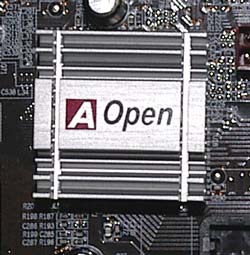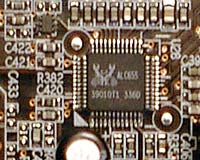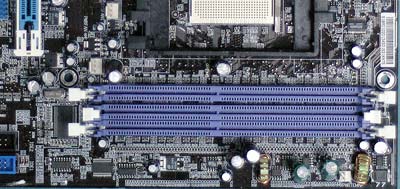AOpen AK86-L UPDATE: Uncommonly Good
by Wesley Fink on March 30, 2004 1:00 PM EST- Posted in
- Motherboards
AOpen AK86-L: Basic Features
| Motherboard Specifications | |
| CPU Interface | Socket 754 Athlon64 |
| Chipset | VIA K8T800/VIA VT8237 |
| Bus Speeds | 200MHz to 255MHz (in 1MHz increments) |
| PCI/AGP Speeds | None. BIOS reports AGP/PCI frequencies as FSB changes |
| Available CPU Ratios | CPU ratios below rated multiplier can be selected in the range of 4x - 16x |
| Core Voltage | Normal, 0.8V to 1.55 V in .025V increments |
| DRAM Voltage | Normal, 2.50V to 2.70V in 0.05V increments |
| AGP Voltage | 1.5V, 1.533V, 1.566V, 1.6V |
| Memory Slots | Three 184-pin DDR DIMM Slots Single-Channel Configuration Regular Unbuffered Memory to 2GB Total |
| Expansion Slots | 1 AGP 8X Slot 5 PCI Slots |
| Onboard Serial ATA RAID | VIA 8237 (2 Drives, 0, 1) |
| Onboard IDE | Two Standard VIA ATA133/100/66 (4 drives) |
| Onboard USB 2.0/IEEE-1394 | 8 USB 2.0 ports supported by 8237 No FireWire ports |
| Onboard LAN | Realtek RTL8110S Gigabit LAN |
| Onboard Audio | Realtek ALC655 codec AC '97 2.3 6-Channel with UAJ |
| BIOS Revision | 1.06M (2/03/2004) |

The packaging is a rather basic green on white, but the feature list is very extensive. For a motherboard selling at a bit less than $100, you get the full range of AOpen features, including SilentTek smart fan controller to lower system noise, EZWin Flash for BIOS updates from Windows, Watch Dog for recovering from bad overclocks, and the EzClock utility for overclocking while in Windows. AOpen includes the VIA RAID driver floppy that is needed for installing the OS with a SATA drive. Many manufacturers have started leaving this necessity out of the box - forcing the installer to find another PC to create the install floppy.

The AK86-L back panel options include 4 USB 2.0 ports, 3 individual mini jacks for audio, Gigabit LAN, PS2 mouse/keyboard ports, Parallel, and a single serial port. There are additional headers on the motherboard for a 2nd serial port and a game port, but brackets for the game and the 2nd serial are not included in the retail package.

The VIA K8T800 is a traditional Northbridge/Southbridge chipset. A large passive heatsink is used on the Northbridge instead of an active solution used in other designs. However, we did not have any overheating problems in our benchmarking. The 8237 Southbridge has much less to do with the memory controller on the Athlon 64 chip, and does not provide any cooling. The Southbridge also remained cool during benchmarking.

AOpen has included provisions for 2 SATA drives supported by the 8237, either regular SATA or SATA RAID 0 or 1.

The AOpen AK86-L uses the Realtek audio codec called ALC655, which is compliant with the latest AC '97 Rev. 2.3. This audio codec features 6-channel sound and UAJ or Universal Audio Jack, with a better than 90db signal-to-noise ratio. This allows automatic jack programming as we've seen on some boards based on Intel's 865/875 chipsets. The ALC655 is quite similar to the Realtek premium ALC658 sound solution. Additional information and specifications are available at Realtek.
While an SPDIF bracket is not included in the AK86-L package, there is an SPDIF I/O header on the motherboard. In addition, there is an audio connection header with connector options and two connectors for Optical Drive audio cables. While the audio input and output options are very good, please keep in mind that you must find and put in additional brackets to use many of the audio options. The brackets are not part of the standard package.

One of the first things that many manufacturers seem to eliminate when they build a $100 board is fan-headers. AOpen has a really effective smart fan control system and they also thoughtfully included five fan headers on the board - four 3-pin headers and one 2-pin temp header. Obviously, it occurred to someone in AOpen engineering that SilentTek was only useful if there were plenty of fan headers on the board. The large number of fan headers will be appreciated by anyone with multiple cooling fans.

The AK86-L includes Realtek Gigabit LAN. LAN connections have moved from added cards to an on-board feature, and we now are starting to see Gigabit LAN become more common, even on boards designed for the mid-to-low price range. Dual color LEDs in the LAN socket indicate 10/100 or Gigabit operation.

Three DIMM slots support standard unbuffered Single-Channel memory. AOpen claims support for up to 2GB of DDR400 memory in 2 DIMMs, and up to 3GB of DDR333 or slower memory in 3 DIMMs.










22 Comments
View All Comments
Pumpkinierre - Monday, February 16, 2004 - link
In your update you say the new BIOS 1.06q includes cpu multipliers. But the old BIOS had that. So does this mean a larger range ie 0.5x divisions? Also now that you've got the Geiger, could you check the PCI lock at several clockspeeds?This is important to me as my interest in purchasing an a64 is to run it at high clockspeed (with only a mild o'clock) as I believe this would substanstially improve gaming performance. Of course this is also dependent on fast low latency DDR 466-500 being available- still yet to occur!.
Boonesmi - Thursday, February 12, 2004 - link
what about agp/pci lock? have you been able to test it yet??Wesley Fink - Thursday, February 12, 2004 - link
AOpen has just sent a revised BIOS 1.06Q, which adds vDimm adjustments from 2.5 to 3.0V in .05V increments. This is an outstanding upgrade from the 2.7v max vDimm in the BIOS we tested and makes the AK86-L one of the best 754 boards available for memory overclocking.A kind soul is hosting the 1.06q BIOS and a link has been added to the review.
JTDC - Tuesday, February 10, 2004 - link
Does anyone know where the 1.06 BIOS revision can be found? I cannot see it on the AOPEN site. Any suggestions as to where I can look?peonyu - Friday, February 6, 2004 - link
I have a Aopen board [not this one though,damn] and the options on it are awesome, same with its stability and performance. The only prob though is the same that this board has - VERY low voltage settings. For reasons i dont understand Aopen is very stubbern with allowing higher voltages, it happens with every board they release. So until they get past that and release a update which increases voltage I dont think it would be worth picking one of these up if your into overclocking.Shinei - Thursday, February 5, 2004 - link
Does Athlon 64 rely on timings as much as the Athlon XP did? I didn't think it did, considering the bandwidth it can use eclipses even the Pentium 4's...As for the article, now I really wish I'd waited a few months to upgrade, instead of going straight for the GA-7N400P2/2800+ in December...
Pumpkinierre - Thursday, February 5, 2004 - link
It would have been nice if you had included some benchmark results at the different multiplier o'clocks or even standardised to 2gig (ie 9x222,8x250) now that you have an A64 board that doesnt have memory, multiplier, HT or (from initial observations) AGP/PCI lock issues. Naturally memory latency settings would have to be kept the same. My pet theory with the A64 is that increasing the RAM speed and lowering memory latency (which appears difficult on many a64 mobo/memory combinations) would be as good as a standard o'clock which to date has'nt been the a64's strong point. This seems like the right board but we're still waiting for CAS2 DDR500.Boonesmi - Thursday, February 5, 2004 - link
dang i really like that board.when are you expecting the "PCI Geiger"??
hehe i want an update :)
Wesley Fink - Thursday, February 5, 2004 - link
#1 - Four "3-pin" fan headers is correct, and the typo is fixed.#2 - We will be reviewing a few of the memory brands you mention in a few weeks. A socket 754 board will be included in the tests.
bhtooefr - Thursday, February 5, 2004 - link
Damn, I want one! Of course, it would be even better if it were Micro ATX... (I've already got a mATX case, and it's very small)